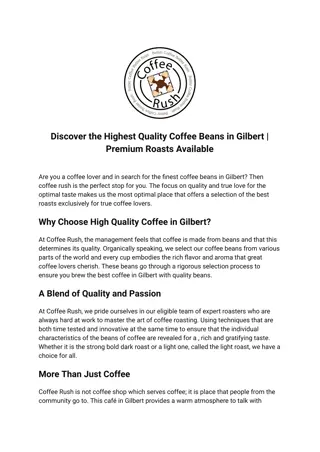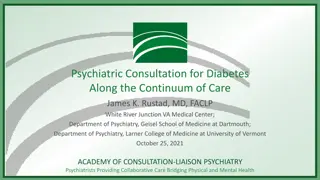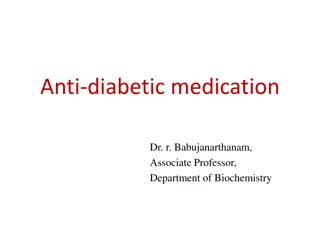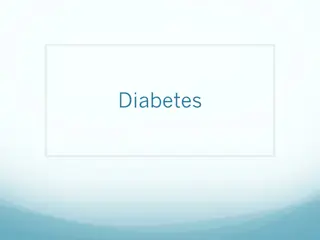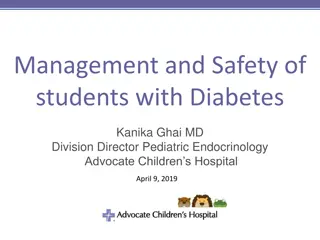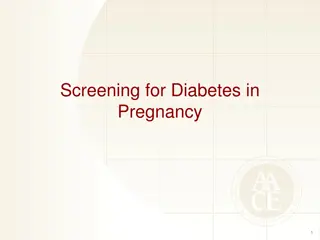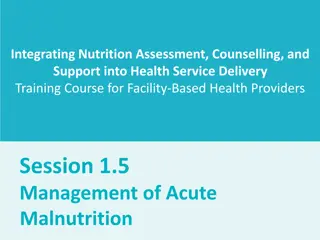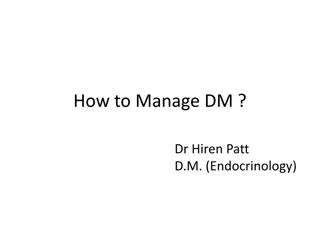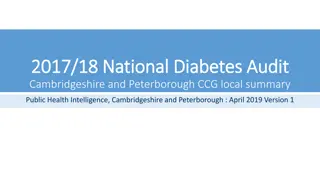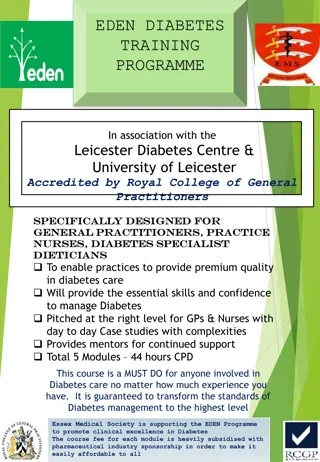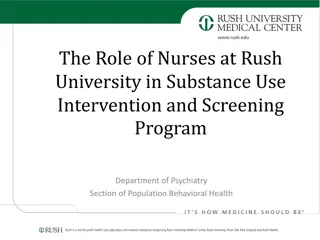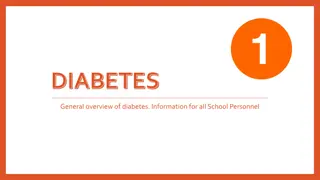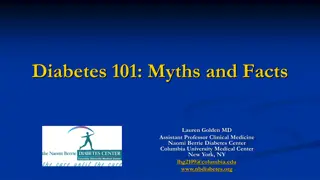Comprehensive Overview of Rush Copley Outpatient Diabetes Center
The Rush Copley Outpatient Diabetes Center, led by Donna Carter RN, CDE, offers a rich history of diabetes treatment, from ancient practices to modern advancements. With a focus on patient education and management, the center serves various diabetes types and provides specialized care, including insulin pump setup, continuous glucose sensor management, and community outreach. Statistics reveal the prevalence and impact of diabetes in the United States, emphasizing the importance of early detection and intervention.
Download Presentation

Please find below an Image/Link to download the presentation.
The content on the website is provided AS IS for your information and personal use only. It may not be sold, licensed, or shared on other websites without obtaining consent from the author. Download presentation by click this link. If you encounter any issues during the download, it is possible that the publisher has removed the file from their server.
E N D
Presentation Transcript
RUSH COPLEY OUTPATIENT DIABETES CENTER Donna Carter RN CDE
This is what we know now This is how much we can still learn
History of Diabetes Earliest known record of diabetes mentioned on 3rd Dynasty Egyptian papyrus mentions polyuria (frequent urination) as a symptom. 11th Century Diabetes was commonly diagnosed by 'water tasters,' who drank the urine of those suspected of having diabetes; the urine of people with diabetes was thought to be sweet-tasting. 1921 Insulin is 'discovered'. A de-pancreatized dog is successfully treated with insulin. 1970 Blood glucose meters and insulin pumps are developed.
History of Diabetes 2018 Continuous Glucose Sensors 288 readings a day No finger pokes! Can give meal time insulin based on the reading seen on the graph 10 14 day wear Insulin pumps Medtronic 670G adjusts basal insulin according to blood sugar levels. Tslim will suspend insulin delivery when blood sugars are low. New insulin Higher concentration Pens that hold higher doses Faster acting meal time insulin
Statistics More than 30 million people in the United States have diabetes, and 1 in 4 of them don t know they have it. More than 84 million US adults over a third have prediabetes, and 90% of them don t know they have it. Diabetes is the 7thleading cause of death in the United States (and may be underreported). Type 2 diabetes accounts for about 90% to 95% of all diagnosed cases of diabetes; type 1 diabetes accounts for about 5%. In the last 20 years, the number of adults diagnosed with diabetes has more than tripled as the American population has aged and become more overweight or obese.
Who Are We? There are 3 CDE s working at the Rush Copley Diabetes Center We have 1 part time dietitian who is working towards her CDE We are open Monday Friday and have evening hours on Tuesday We are recognized by the American Diabetes Association We are certified in Insulin Pumps and Continuous Glucose Sensors
What Do We Do? The Rush Copley Diabetes Center sees: Type 1 patients Type 2 patients Gestational diabetes High Risk patients admitted to the hospital We teach: Diabetes Education Diabetes self management Medical nutrition therapy Insulin teaching and administration Insulin pump set up and management Continuous Glucose Sensor set up and management Medical Nutrition Therapy Safe at School Act Community health fairs
Who Are We Helping? In 2017 we had a total of 1150 patient visits Of those patients seen, a total of 153 patients used our charitable resources This amounted to 352 patient visits or 1/3 that used charitable resources More than are in their 20 s and 30 s More than are Hispanic More than 1/3 (38 patients) have Gestational Diabetes
Gestational Diabetes Rush Copley is the 6th busiest Birthing Center in the state. GDM can cause Increased birth weights Shoulder distocia Cord compression Can lead to Type 2 diabetes in 5-10 years
Why diabetes education is important DIABETES EDUCATION REDUCES RISKS of readmission/complications In a systematic review that included 118 unique interventions, data analysis revealed an average reduction in A1C of 0.57 for persons with type 2 diabetes who received diabetes self-management education (DSME) compared to those who did not; this statistically significant reduction demonstrated that engagement in DSME results in substantial and significant improvements in glycemic control in persons with type 2 diabetes. Chrvala CA, Sherr D, Lipman RD. Patient Educ Couns. 2016 Jun;99(6):926-43.
Diabetes Education The burden of diabetes among hospitalized patients, however, is substantial, growing, and costly, and readmissions contribute a significant portion of this burden Reducing readmission rates of diabetic patients has the potential to greatly reduce health care costs while simultaneously improving care
INSURANCE COVERAGES REIMBURSEMENT Commercial insurance most often covers outpatient diabetes education The cost of diabetes education at Rush Copley Diabetes Center is $128.00 per uninsured/underinsured patient If we successfully treat them and prevent admission/readmission we are saving $1,141.00 per patient
GRANT FUNDING We have more patients who are being seen by their PCP via the expansion of Medicaid More patients are being referred and seen Budget for this program is estimated to be $19,600 for 2019 Our sustainable income each year is approximately $9,000 This year were able to partner with . Rush Copley Foundation s Rock The Heart $5,000 Last Friday in September and held at BallyDoyle Janssen Pharmaceutical donated $2,500 Medtronic diabetes donated $1,150 Employee Giving Campaign $4,000
NEED IS GROWING Over the last 3 years we have seen an increase in the number of patients seen who are uninsured or have Medicaid insurance that does not reimburse for diabetes/gestational diabetes education Cy 15 85 Cy 16 106 CY 17 153 CY 18 141 (YTD - 1/1/2018 11/9/2018)
Story When Stephanie was admitted to Rush Copley several summers ago, her blood sugar level was out of control nearly 14% When she got out of the hospital, she was referred to our Outpatient Diabetes Education Center where we worked with her one-on-one to give her the personalized support she needed to manage her diabetes Poverty complicated the challenges she was facing. Imagine trying to focus on a healthy diet, regular exercise and glucose monitoring when you aren t sure you can cover your basic living costs from one month to the next With our help, her blood sugar level dropped to a healthy 6.2% within six months. She has continued to improve her lifestyle and has maintained an A1c less than 7%
Future CURE! Continue to raise funds that will allow the Rush Copley Diabetes Center to see patients who are uninsured/underinsured Reduce the risks of long-term complications by offering evidence based education CURE!!!
My diahero s!! Cole Edelman Age 5 Cole Smythe Age 10




